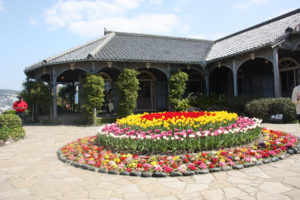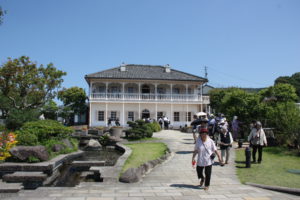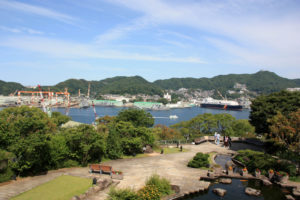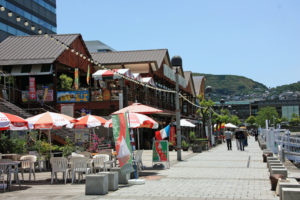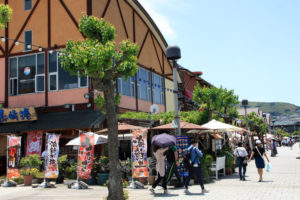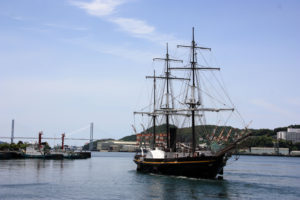The 26 Martyrs Museum
The 26 Martyrs Museum is dedicated to the 26 Christians who were executed here on
February 5, 1597. They included both foreign missionaries and Japanese laymen. Missionary
activities were prohibited at the time, and Japan’s ruler Toyotomi Hideyoshi staged the execution
as a warning. The monument is located in a small park on a hill not far from Nagasaki Station
and offers nice views over the city.
A straight red line runs from the Monument across the park’s plaza in the direction of the Oura
Cathedral on the opposite side of the city. Oura Cathedral is also dedicated to the 26 martyrs.
 |
 |
 |
The museum behind the monument is devoted to the memory of the martyrs and to Christianity in
Japan in general. Its interior is reminiscent of a church with stained-glass windows, making for
atmospheric viewing of the exhibits. On display are artifacts related to Christianity in Japan,
including old documents, statues and jewelry.
 |
 |
 |
 |
 |
 |
General information
| Address | 7-8 Nishizaka-cho, Nagasaki-city |
| Access | 5 minuts walk from JR Nagasaki Station |

Dejima
Dejima was the fan-shaped artificial island in the bay of Nagasaki where was used
as a trading port during Japan’s National isolation of Edo period.
In 1636, the artificial island, Dejima was constructed to accommodate Portuguese
who lived in Nagasaki and to prohibit Christian missionary work.
In 1638, trade with Portugal was prohibited and Dejima becaome an uninhabited island.
In 1641, the Dutch trading post in Hirado was moved to Dejima, and then the history of
trade with the Dutch began at Dejima as only the gateway to European in Japan
Many European technologies and cultures were introduced here through Dutch until 1853.
|
Entrance of Dejima |
Fan-shaped artificial island, was built in 1636 |
Dejima used from 1641 until 1853 |
A project to restore Dejima is underway. In 2000, five buildings including the Deputy Factor’s
Quarters were completed and opened to the public.
|
Dejima International Club
|
Building of residence, cooking room, warehouse |
The old Dejima seminary, a Christian theological school |
In the spring of 2006, the finishing touches were put on the Chief Factor’s Residence, the
Japanese Officials’ Office, the Head Clerk’s Quarters, the No. 3 Warehouse and the Sea Gate.
 |
|
|
 |
 |
 |
|
|
|
|
|
|
 |
|
General information
| Address | 6-1 Dejima-machi, Nagasaki-city |
| Access |
a short walk from Dejima Tram station |
| Open hours | 8:00 to 21:00 |
| Admission fee | JPY 510 |
| Days closed | No closing days |

Glover Garden
Glover Garden is located on Minami-Yamate hill in Nagasaki-city, and nine traditional buildings
can be seen at Glover Garden. Among these, the Glover Residence, Orto Residence, and Ringer
Residence were built during the settlement era and are valuable buildings that have continued to
stand on this land for over 150 years.
Glover Garden boasts a great location overlooking Nagasaki Port with Mt. Inasa, a landmark
of Nagasaki-city, in the background.
In 1858, the Edo shogunate concluded treaties of amity and commerce with five countries:
the United States, the Netherlands, Russia, England, and France, and foreign merchants
with dreams came together to visit Japan as it entered a new era. Western-style buildings
covered with Japanese-style roof tiles line the hill overlooking Nagasaki Port, and these are
where the daily lives of foreigners from all over the world lived. “Glover Garden” is located here.
You can feel the history of Nagasaki from the end of the Edo period to the Meiji period in this
area, where the residences of foreigners from the settlement era, including the adventuring
merchant Thomas Glover, and the Western-style houses that were scattered throughout
Nagasaki-city are gathered.
|
Glover Residence, World Heritage |
Former Mitsubishi second dock house |
Overlooking of Nagasaki Port |
Glover Residence
Glover Residence is Japan’s oldest wooden Western-style building and is the UNESCO
World Heritage registered in 2015 as Sites of Japan’s Meiji Industrial Revolution
In 1859 an enterprising Scotsman named Thomas Glover arrive in Nagasaki and immediately
become involved in a variety of businesses. Glover operated a coalmine, founded the first
modern shipyard in Japan, supplied weapons to Satsuma clan in Southern Kyushu and
established Japan’s Kirin beer brewery. The Glover residence, built in 1863, evokes an era when
Western architecture and lifestyle were of great interest to Japanese. Several other merchant
houses have been relocated to the Glover Garden, which surrounds the house itself, making the
area a pocket of 19th-cencury Western culture overlooking Nagasaki Bay.
Inside of the residence
 |
 |
 |
Nagasaki harbor view from Glover Garden
|
Venus Bridge |
Mitsubishi Heavy Industries, repair dock |
Giant Cantilever Crane, World Heritage |
Golver Residence is generally believed to have been the scene of Puccini’s opera, Madame
Butterfly. Inside the park is the life-size statue of the famous opera singer, Tamaki Miura, who
received international acclaim for her performance as Cho-Cho-san in Madam Butterfly.
 |
 |
 |
General information
| Address | 8-1 Minamiyamate-machi, Nagasaki-city |
| Access |
10 minutes walk from Oura tensyudo-mae tram station through in front of Oura Cathedral |
| Open hours | 8:00 to 18:00, until 21:00 in summer time and peak season |
| Admission fee | JPY 610 |
| Days closed | No closing days |

Sotome Pilgrimage sites
Sotome is located between Nagasaki-city and Saikai-city, and face to East China Sea.
During the ban on Christianity from 17 century to end of the 19 century, Sotome was
home to communities of “Hidden Christians”, many of whom emigrated there from
other parts of Nagasaki as the remote region allowed them to practice their religion
in secret.
French missionary Father Marc Marie de Rotz played a large role in reestablishing the
religion in the area. He established Shitsu Church on a hill overlooking the sea.
On an elevation commanding a view over the Sea of Goto, Father Marc Marie de Rotz
established a church at his own expense 1882. The building was extended and renovated
again and again. A statue of Mary that he ordered from France is standing in the bell tower.
 |
 |
 |
I want to save people in the Sotome from poor life. Former Shitsu Aid Centeris indispensable in
talking about the history and culture of the region.
 |
 |
 |
The setting of Endo Shusaku’s novel Silence. Sotome is blessed with a unique history and
culture of Christianity. In particular, the area in which the Endo Shusaku Literary Museum
stands is known as the site of a Christian village, one of Endo’s most notable work, Silence.
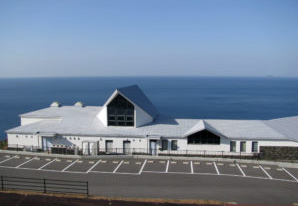 |
 |
 |
The Church is located in Kurosaki district, where was place of the setting for Endo Shusaku’s
novel Silence. In 1897, the foundations were laid down according to Father de Rotz’s design.
Construction followed and in 1920 the church was completed. The followers built it brick by
brick with their own hands. The modest design serves to bring out the beauty of the bricks.
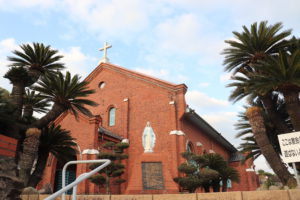 |
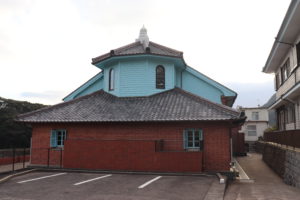 |
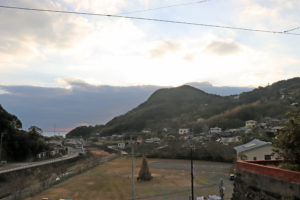 |
|
|
|
|
General information
| Address | Shitsu, Nagasaki-city |
| Access | 50 minutes by a vehicle from JR Nagasaki Station |

Home Tailor-made tours Study tours Christian Pilgrimage tours Golf tour Kyushu tour packages
Tram in Nagasaki
The Nagasaki Electric Tramway provides a convenient and affordable way to travel around
the main attractions of Nagasaki-city.
 |
 |
 |
No matter how far you travel, the adult fare for a single journey is always 130 yen.
A one-day pass offering unlimited rides for 500 yen is also available for purchase at major
information centers, hotels, and through a smartphone app (but not on board the trams).
Announcements and signs both on trams and at the stops are available in English, making
it easy to find which tram you need to take and where to get off.
Tram Route


Home Tailor-made tours Study tours Christian Pilgrimage tours Golf tour Kyushu tour packages
Nagasaki Wharf
Elegant international & domestic tourist harbour. Made up of around 20 unique shops and
restaurants lined up at the water front, offering various choices such Japanese, Western,
and Italian cuisine, to beauty salons, outdoor shops and more.
|
|
|
|
It is quite the popular spot for people who want to relax while viewing the sea beyond as they
dine outdoors.
 |
 |
 |
Nagasaki Harbour
Located in the center of East Asia and is surrounded by the beautiful green mountains.
The city has flourished due to foreign trade through the port. Now the port is home to Mitsubishi
Heavy Industries, which has one of Japan’s largest shipbuilding facilities.
|
|
|
|
Not only ships but also many industrial goods such as wind and thermal generators are
manufactured and exported from Nagasaki. Recently, the port was changed by the appearance of
a beautiful park and Venus Bridge or the long cable-stay bridge. The port facilities will be further
improved as a major gateway with a long tradition of international exchange and together with a
geographically advantageous location.
|
|
|
|
General information
| Address | 1-1 Dejima-machi, Nagasaki-city |
| Access |
a short walk from Dejima Tram Station a short walk from Tsuki-machi Tram Station 15 minutes walk from JR Nagasaki Station |

Home Tailor-made tours Study tours Christian Pilgrimage tours Golf tour Kyushu tour packages
Peace Statue
World Peace from Nagasaki. The Peace Statue was completed in 1955, ten years after the
atomic bombing. The 9.7 meter high statue sitting on a 4 meter tall pedestal, made by renown
sculptor Kitamura Seibo who born in Minami-Shimabara-city, Nagasaki-prefecture in 1884.
The bronze Peace Statue has one left arm extending horizontally and other right arm pointing
to the sky. The left arm stretching to the horizon symbolizes world peace, and the other right
pointing skyward indicates the threat of atomic destruction (the harm of nuclear power).
The closed eyes show the prayer for the peaceful repose of the victims of the Atomic Bomb.
|
Visiting from all over Japan and the World |
Wishing for eternal world peace from Nagasaki |
Kitamura Seibo, the Statue was completed at the age of 71 |
Peace Memorial Ceremony is held in front of the statue on August 9 every year and
the Mayor of Nagasaki makes the “Nagasaki peace declaration” for the whole world.
Commitment to World Peace from all over the World
 |
 |
 |
 |
 |
 |
 |
 |
 |
 |
 |
 |
 |
 |
 |
 |
 |
General information
| Address | Heiwakoen, Matsuyama-machi, Nagasaki-city |
| Access | 5 minutes walk from Heiwa-koen-shita Tram Station |

Home Tailor-made tours Study tours Christian Pilgrimage tours Golf tour Kyushu tour packages
China town
China town at shinchi is one of the big three china town in Japan. There are about
50 Chinese restaurants and many Chinese sundries shops in there.
 |
|
|
|
|
|
|
 |
 |
 |
An annual festival in Nagasaki held on Chinese new year. The festival has been started to
celebrate a new year by Chinese who lived in Nagasaki, and it became the Nagasaki’s festival
since 1994. More than 10 thousand lanterns are decorated at China town during the festival.
 |
 |
 |
General information
Access : a short walk from Shinchi-chukagai Tram Station

Martyrdom of the 26 Saints of Japan
Nishizaka Hill in Nagasaki is the place of Martyrdom of 26 Japanese Saints. The 26 Martyrs of
Japan were a group of Catholics who were executed by crucifixion on February 5, 1597.
The Twenty-six Christians, including six foreign missionaries and three young boys, were arrested
in Kyoto and Osaka on the order of Toyotomi Hideyoshi, the National ruler, for preaching Christianity.
They were marched 800 km through the snow to Nagasaki and crucified in front of large crowd on
Nishizaka hill on Feb. 5, 1597.
Their martyrdom is especially significant in the history of the Catholic Church in Japan. In 1950, Pope
Pius XII designated this place as an official pilgrimage site for Catholics. Pope John Paul II visited
here in 1981, and Saint Teresa of Calcutta commonly known as Mother Teresa visited in 1982.
Paulo Miki and 25 others were crucified for their belief in God on order of Toyotomi Hideyoshi.
The martyrs including four Spaniards, one from Goa, India, one Mexican and 20 Japanese
demonstrated their spiritual unity despite differences in races, ages and professions.
|
Nishizaka hill, the site of Martyrdom in 1597 |
The martyrs said that ” All people, bless God ! ” |
The 26 Japanese martyrs have been canonized in 1862 |
The museum behind the monument is devoted to the memory of the martyrs and to Christianity in
Japan in general. Its interior is reminiscent of a church with stained-glass windows, making for
atmospheric viewing of the exhibits. On display are artifacts related to Christianity in Japan,
including old documents, statues and jewelry.
 |
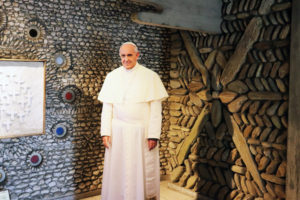 |
 |
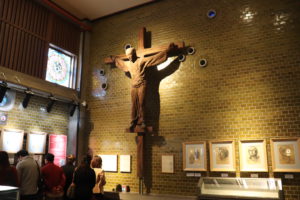 |
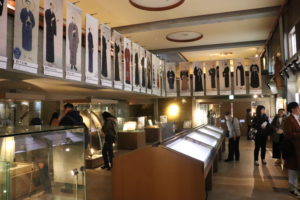 |
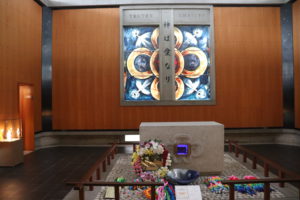 |
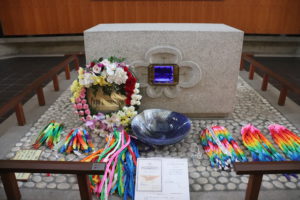 |
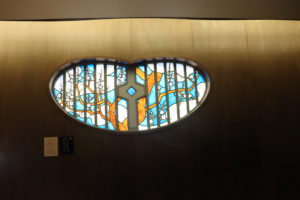 |
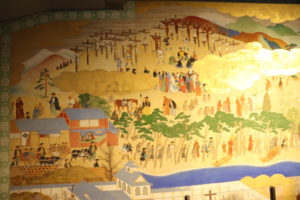 |
General information
| Address | 7-8 Nishizaka-cho, Nagasaki-city |
| Access | 5 minutes walk from JR Nagasaki Station |

Oura Cathedral
The Cathedral is one of the significant Christian Pilgrimage site in Japan. Established 1865,
this church is officially known as “Oura Cathedral, the Church of 26 Martyrs.” It was built by
the French priest Bernard Petitjean of Fier who had been dispatched by the Foreign
Missionary Church of Paris to dedicate prayers to the 26 saints martyred on Nishizaka hill.
For this reason, the church faces Nishizaka hill. It was designated as a National Treasure in
1933 for its value as Japan’s oldest Gothic-style Cathedral.
|
|
|
|
“On March 17, 1865, a group of peasants from Urakami came to the church and professed
their faith to Father Petitjean, thus revealing that Christianity had survived through the
centuries of persecution. The white marble statue of the Holy Mother at the entrance was built
in commemoration of the dramatic discovery of the “Hidden Christians.
|
|
|
|
General information
| Address | 5-3 Minamiyamate, Nagasaki-city |
| Access |
10 minutes walk from Oura tensyudo-mae tram station |
| Open hours | 8:00 to 17:45 |
| Admission fee | JPY 1,000 |
| Days closed | No closing days |

Home Tailor-made tours Study tours Christian Pilgrimage tours Golf tour Kyushu tour packages














